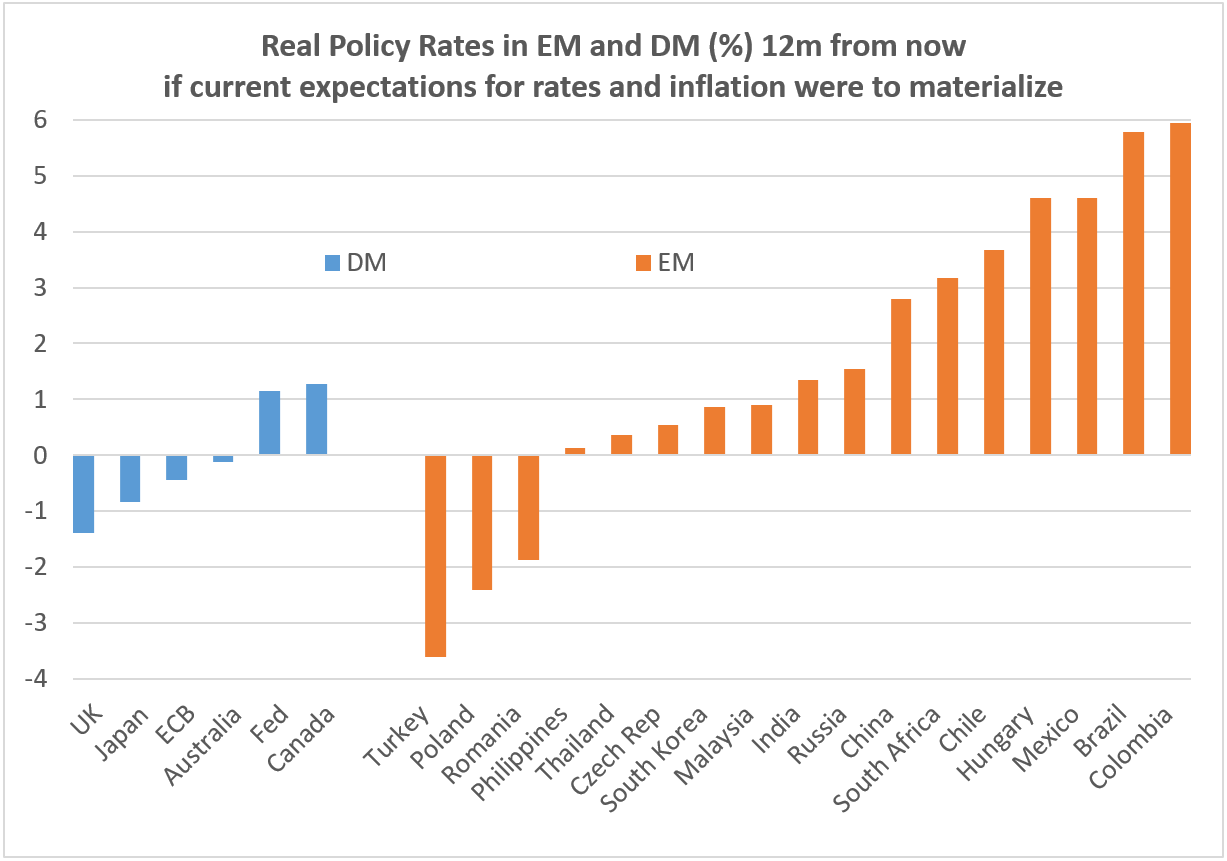Rate Cuts, Anyone?
September 14, 2022
Read Time 2 MIN
Room For Rate Cuts In EM
This might be a strange question to ask on a day after the US inflation scare, which pushed the market expectations for the next week’s Federal Reserve rate hike to 83bps (followed by +68bps in November). But this is what “we, the market,” see happening in major emerging markets (EMs) from Q2-23 onwards (or even earlier in some cases). The chart below might help to explain why. Aggressive frontloading of rate hikes – especially in Europe, the Middle East and Africa (EMEA), and Latin America (LATAM) – and peaking inflation should translate into some seriously positive real policy rates twelve months from now. And these rates might prove too restrictive against the backdrop of multiple growth headwinds. The latest International Monetary Fund (IMF) growth projections (updated in July) show a slightly higher real growth rate in EM in 2023 compared to 2022. Still, the outlook varies a lot, country by country. The consensus forecast for Chile, for example, drops from a respectable 2% this year to practically zero in 2023. The 2022 real GDP growth is expected to slow to 1.3% in the Czech Republic and 1.5% in Mexico. Brazil might have dodged a recession bullet in 2022, but the pace of economic expansion is currently expected to slow to less than 1% in 2023.
EM Policy Easing Trailblazers
The current market pricing shows EMEA and LATAM leading the easing wave in EM, and the local swap curve points to a possible rate cut in the Czech Republic before the year-end. The Czech national bank had already surprised on the dovish side by staying on hold in August. And the latest downside inflation surprise suggests that the hiking cycle might indeed be over. Brazil is also expected to stay on hold next week – despite Governor Roberto Campos Neto’s hawkish comments a few days ago (in which he alluded to a potential small final rate hike). Chile is not there yet, but the latest developments on the political front – the rejection of the populist constitutional draft – pave the way for a more reasonable (orthodox) fiscal stance, which should open room for rate cuts in 2023.
EM Catch-Up Rate Hikes
We often say that EM is not a monolith, and a number of EMs are still in a catch-up tightening mode. Analysts are still debating whether South Africa will go for another large (+75bps) rate hike next week. Hungary might take its policy rate above 12% after a fiscal adjustment setback in August. Mexico’s central bank sounded hawkish enough to support the expectation of a 75bps move at the next meeting. Indonesia and the Philippines are expected to hike more next week. We also keep wondering whether today’s inflation print in Argentina (which should bring headline inflation closer to 80%) would encourage the central bank to go for another large rate hike after a 800bps+950bps “double punch” in the summer. Argentina just got a nod from the IMF (which praised steps to stabilize the economy), so it might continue being on best behavior. Stay tuned!
Chart at a Glance: EM Real Policy Rates – Ready for a Trim?

Source: VanEck Research; Bloomberg LP.
Related Topics
Related Insights
February 26, 2024
January 04, 2024
October 27, 2023
PMI – Purchasing Managers’ Index: economic indicators derived from monthly surveys of private sector companies. A reading above 50 indicates expansion, and a reading below 50 indicates contraction; ISM – Institute for Supply Management PMI: ISM releases an index based on more than 400 purchasing and supply managers surveys; both in the manufacturing and non-manufacturing industries; CPI – Consumer Price Index: an index of the variation in prices paid by typical consumers for retail goods and other items; PPI – Producer Price Index: a family of indexes that measures the average change in selling prices received by domestic producers of goods and services over time; PCE inflation – Personal Consumption Expenditures Price Index: one measure of U.S. inflation, tracking the change in prices of goods and services purchased by consumers throughout the economy; MSCI – Morgan Stanley Capital International: an American provider of equity, fixed income, hedge fund stock market indexes, and equity portfolio analysis tools; VIX – CBOE Volatility Index: an index created by the Chicago Board Options Exchange (CBOE), which shows the market's expectation of 30-day volatility. It is constructed using the implied volatilities on S&P 500 index options.; GBI-EM – JP Morgan’s Government Bond Index – Emerging Markets: comprehensive emerging market debt benchmarks that track local currency bonds issued by Emerging market governments; EMBI – JP Morgan’s Emerging Market Bond Index: JP Morgan's index of dollar-denominated sovereign bonds issued by a selection of emerging market countries; EMBIG - JP Morgan’s Emerging Market Bond Index Global: tracks total returns for traded external debt instruments in emerging markets.
The information presented does not involve the rendering of personalized investment, financial, legal, or tax advice. This is not an offer to buy or sell, or a solicitation of any offer to buy or sell any of the securities mentioned herein. Certain statements contained herein may constitute projections, forecasts and other forward looking statements, which do not reflect actual results. Certain information may be provided by third-party sources and, although believed to be reliable, it has not been independently verified and its accuracy or completeness cannot be guaranteed. Any opinions, projections, forecasts, and forward-looking statements presented herein are valid as the date of this communication and are subject to change. The information herein represents the opinion of the author(s), but not necessarily those of VanEck.
Investing in international markets carries risks such as currency fluctuation, regulatory risks, economic and political instability. Emerging markets involve heightened risks related to the same factors as well as increased volatility, lower trading volume, and less liquidity. Emerging markets can have greater custodial and operational risks, and less developed legal and accounting systems than developed markets.
All investing is subject to risk, including the possible loss of the money you invest. As with any investment strategy, there is no guarantee that investment objectives will be met and investors may lose money. Diversification does not ensure a profit or protect against a loss in a declining market. Past performance is no guarantee of future performance.
PMI – Purchasing Managers’ Index: economic indicators derived from monthly surveys of private sector companies. A reading above 50 indicates expansion, and a reading below 50 indicates contraction; ISM – Institute for Supply Management PMI: ISM releases an index based on more than 400 purchasing and supply managers surveys; both in the manufacturing and non-manufacturing industries; CPI – Consumer Price Index: an index of the variation in prices paid by typical consumers for retail goods and other items; PPI – Producer Price Index: a family of indexes that measures the average change in selling prices received by domestic producers of goods and services over time; PCE inflation – Personal Consumption Expenditures Price Index: one measure of U.S. inflation, tracking the change in prices of goods and services purchased by consumers throughout the economy; MSCI – Morgan Stanley Capital International: an American provider of equity, fixed income, hedge fund stock market indexes, and equity portfolio analysis tools; VIX – CBOE Volatility Index: an index created by the Chicago Board Options Exchange (CBOE), which shows the market's expectation of 30-day volatility. It is constructed using the implied volatilities on S&P 500 index options.; GBI-EM – JP Morgan’s Government Bond Index – Emerging Markets: comprehensive emerging market debt benchmarks that track local currency bonds issued by Emerging market governments; EMBI – JP Morgan’s Emerging Market Bond Index: JP Morgan's index of dollar-denominated sovereign bonds issued by a selection of emerging market countries; EMBIG - JP Morgan’s Emerging Market Bond Index Global: tracks total returns for traded external debt instruments in emerging markets.
The information presented does not involve the rendering of personalized investment, financial, legal, or tax advice. This is not an offer to buy or sell, or a solicitation of any offer to buy or sell any of the securities mentioned herein. Certain statements contained herein may constitute projections, forecasts and other forward looking statements, which do not reflect actual results. Certain information may be provided by third-party sources and, although believed to be reliable, it has not been independently verified and its accuracy or completeness cannot be guaranteed. Any opinions, projections, forecasts, and forward-looking statements presented herein are valid as the date of this communication and are subject to change. The information herein represents the opinion of the author(s), but not necessarily those of VanEck.
Investing in international markets carries risks such as currency fluctuation, regulatory risks, economic and political instability. Emerging markets involve heightened risks related to the same factors as well as increased volatility, lower trading volume, and less liquidity. Emerging markets can have greater custodial and operational risks, and less developed legal and accounting systems than developed markets.
All investing is subject to risk, including the possible loss of the money you invest. As with any investment strategy, there is no guarantee that investment objectives will be met and investors may lose money. Diversification does not ensure a profit or protect against a loss in a declining market. Past performance is no guarantee of future performance.

